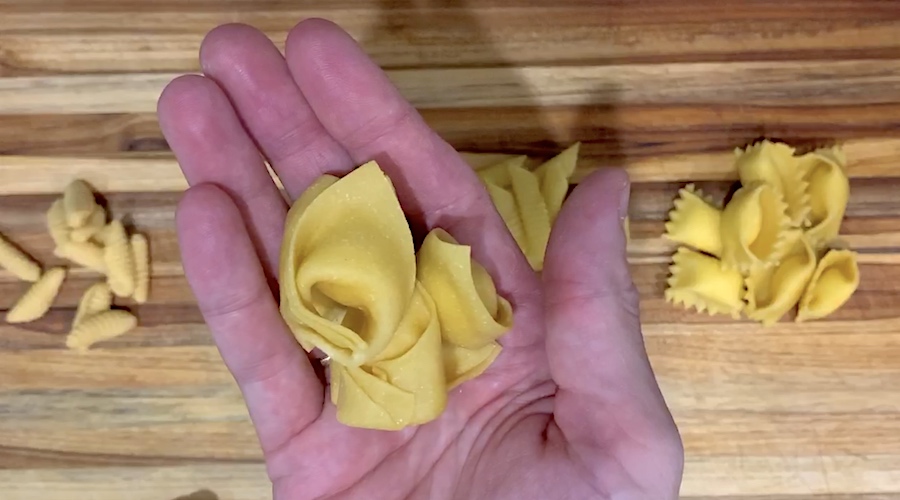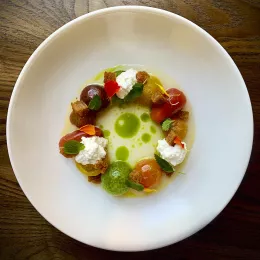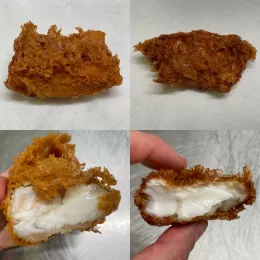The beauty of learning to cook Italian cuisine, in Module 3 of the Culinary Arts program, is understanding the many regional dishes that make up Italian food. Studying pasta shapes, fillings and sauces helps aspiring chefs to identify regions and the landscapes, climate and agricultural history influencing the ingredients used in each dish.
Rolling out pasta shapes with fresh dough can be therapeutic, fun and enjoyable with family and friends and only requires eggs and flour. There are many ways to make each pasta shape, differing between Italian households. Here are a few that you can try to keep challenging yourself while you stay home.
Agnolotti del Plin
Agnolotti are traditional stuffed pastas from Piedmont. Plin means "pinch" in the region's dialect and refers to the signature pinched and rolled shape. Agnolotti should be small in size and often have a braised meat filling.
For this pasta, use:
- 400 grams “00” flour
- 40 grams semolina flour
- 48 grams high-quality fresh egg yolks
- 3 high-quality fresh eggs
Place a small amount of filling in the center of a sheet of pasta, leaving a gap no wider than a finger's width. Roll from bottom to top. Using your index fingers and thumbs on both hands, pinch in between the fillings and squeeze. You should see the filling bulge upwards and hold its shape vertically in the pasta.
Once you have done this, use a fluted pasta wheel to trim the pasta edge furthest away from you so that when folded from bottom to top, the edges meet perfectly. Discard excess dough. Your sheet should resemble an “L” shape at this point. In between each filling, roll from bottom to top. This will seal in between each piece of pasta and leave a flap that can capture sauce.
Cavatelli
Cavatelli are small, elongated shell shapes. The pasta is traditionally made with a semolina and water dough and commonly paired with broccoli rabe and garlic. For this dough, use a blend of:
- 300 grams “00” flour
- 80 grams semolina flour
- Water, to bind
To make cavatelli, mix water, semolina flour and “00” flour together and knead for around 10 minutes until smooth and elastic. Roll out thin tubular strands of dough around 1/4-inch thick.
Cut into 1/4-inch-wide pieces.
Using either your index and middle fingers or, as I have, a bench scraper to drag the dough towards you, rolling over a ridged pasta board. The pasta pieces should shape to allow an indent in the center which will capture the sauce like a long seashell.
Garganelli
Gargenelli are tubular pasta shapes made with an egg dough. Small squares are shaped from a large sheet of dough and rolled around a small piece of wood. Ridges can be added to the garganelli by rolling over a wooden board with ridges.
For this pasta, use a firm egg dough made with:
- 400 grams “00” flour
- 40 grams semolina flour
- 48 grams high-quality fresh egg yolks
- 3 high-quality fresh eggs
Place a square of pasta on the board with the corner facing you. Place your rolling stick on top just above the bottom edge. Roll around and tuck in. Press evenly, rolling the tube away from you. Slide the tube of pasta from the wood and collect on one side. Repeat the process.

Tortellini
This small ring-shaped pasta is traditionally from the Emilia-Romagna region of Italy. Tortellini are usually made with a meat-based filling, served in brodo and are smaller than their larger cousin, tortelloni, which are usually stuffed with a cheese filling such as ricotta.
For this pasta, use:
- 14 high-quality fresh egg yolks
- 1 high-quality fresh egg, whole
- 300 grams “00” flour
Roll out pasta and cut even squares around 4-5 cm. Place a small amount of filling in the center, around 2 grams. Place one corner towards you and fold up the bottom to top. Press the open edges down to seal in the filling. Push gently in the center of the flat edge, now facing you. Pinch the right-hand corner with your right index finger and thumb; with the left hand, pull the left-hand corner over your right index finger, and squeeze together to seal.
Learn more about pasta and regional specialties from scratch in Culinary Arts.




